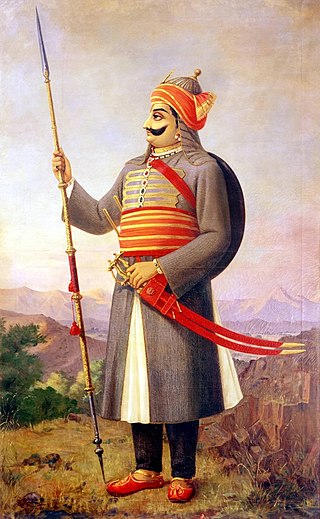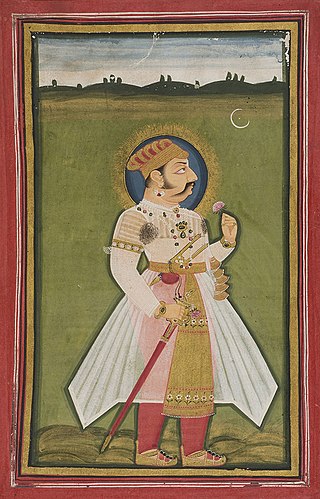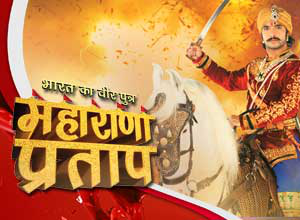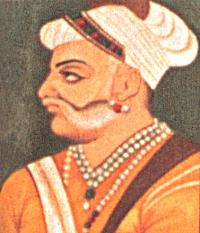
Sangram Singh I, commonly known as Rana Sanga, was the Rana of Mewar from 1508 to 1528 CE. A member of the Sisodia dynasty, he controlled parts of present-day Rajasthan, Gujarat and Madhya Pradesh with his capital at Chittor. His reign was admired by several of his contemporaries, including the first Mughal Emperor Babur, who described him as the "greatest Indian ruler" of that time. The Mughal historian Abd al-Qadir Badayuni called Sanga the bravest of all Rajputs along with Prithviraj Chauhan also known as Rai Pithaura.

Pratap Singh I, popularly known as Maharana Pratap, was king of the Kingdom of Mewar, in north-western India in the present-day state of Rajasthan, from 1572 until his death in 1597. He is notable for leading the Rajput resistance against the expansionist policy of the Mughal Emperor Akbar including the Battle of Haldighati and the Battle of Dewair.
The Sisodia was an Indian royal dynasty belonging to the clan that ruled over the Kingdom of Mewar, in the region of Mewar in Rajasthan. The name of the clan is also transliterated as Sesodia, Shishodia, Sishodia, Shishodya, Sisodya, Sisodiya, Sisodia.

Chittorgarh is a major city in the state of Rajasthan in western India. It lies on the Berach River, a tributary of the Banas, and is the administrative headquarters of Chittorgarh District. It was a major stronghold of the Rajput State of Medapata. The city of Chittorgarh is located on the banks of river Gambhiri and Berach.

Kumbhkaran Singh (1417–1468), popularly known as Maharana Kumbha, was the ruler of the Kingdom of Mewar. He belonged to the Sisodia clan of Rajputs. It was during his reign that Mewar became one of the most powerful political powers in northern India. He is considered to be the most powerful ruler of his time in India.

Chittorgarh, also known as Chittod Fort, is one of the largest forts in India. It is a UNESCO World Heritage Site. The fort was the capital of Mewar and is located in the present-day city of Chittorgarh. It sprawls over a hill 180 m (590.6 ft) in height spread over an area of 280 ha above the plains of the valley drained by the Berach River. The fort covers 65 historic structures, which include four palaces, 19 large temples, 20 large water bodies, 4 memorials and a few victory towers.
Udai Singh II was the 12th Maharana of the Kingdom of Mewar and the founder of the city of Udaipur in the present-day state of Rajasthan, India. He was the fourth son of Rana Sanga and Rani Karnavati, a princess of Bundi.

The Kingdom of Mewar was an independent kingdom that existed in the Rajputana region of the Indian subcontinent and later became a major power in medieval India. The kingdom was initially founded and ruled by the Guhila dynasty followed by the Sisodiya Dynasty. The kingdom came to be known as the Udaipur State after it became a princely state in the nineteenth century.

Rani Karnavati, also known as Rani Karmavati, was a princess and temporary ruler from Bundi, India. She was married to Rana Sanga of Mewar. She was the mother of the next two Ranas, Rana Vikramaditya and Rana Udai Singh, and grandmother of Maharana Pratap. She served as regent during the minority of her son, from 1527 until 1533. She was as fierce as her husband and defended Chittor with a small contingent of soldiers until it inevitably fell to the Gujarat army which was led by Bahadur Shah of Gujarat. She refused to flee and performed johari to protect her honor.
Rana Raimal Singh, also known as Rana Raimal, was the Sisodia Rajput ruler of the Kingdom of Mewar. Rana Raimal was the younger son of Rana Kumbha and younger brother of his predecessor Rana Udai Singh I and father of Rana Sanga.

Maharana Pratap: The First Freedom Fighter is an Indian epic film based on Maharana Pratap of Mewar .The film is directed and produced by Dr. Pradeep Kumawat from Udaipur, Rajasthan. It is the first time that a film has been made on the history of Maharana Pratap. The film's sound track includes one of the last songs sung by Late Jagjit Singh.

Bharat Ka Veer Putra – Maharana Pratap is an Indian historical fiction series produced by Contiloe Entertainment. It is based on the life of Maharana Pratap, a sixteenth century ruler of Mewar kingdom. It starred Sharad Malhotra, Rachana Parulkar, Faisal Khan and Roshni Walia.

Maharana Amar Singh I, the Maharana ruler of Mewar Kingdom, was the eldest son and successor of Maharana Pratap I. He was the 14th Rana of Mewar, ruling from 19 January 1597 until his death on 26 January 1620.

Maharana Raj Singh I, was the Maharana of Mewar Kingdom and eldest son of Maharana Jagat Singh I. He fought against Mughal Empire and annexed many Mughal territories He participated in Rajput-Mughal War (1679–1707) and defeated the Mughals.
Rana Vikramaditya was the Sisodia Rajput ruler of Mewar Kingdom ,younger son of Rana Sanga and the elder brother of Rana Udai Singh II. He was unpopular amongst the nobles of Mewar. During his brief reign, Chittor was sacked by Bahadur Shah of Gujarat however Bahadur Shah was not able to hold Chittor for long and the Sisodia's recaptured it within a short time of his departure.
Ajabde Panwar, popularly known as Maharani Ajabde, was the queen of Kingdom of Mewar. Ajabde is the chief consort and first wife of Maharana Pratap, and the mother of Amar Singh I. She was known for her beauty, intelligence and influence in Pratap's life.

Rao Ganga or Rav Gango Vaghavat was an Indian king from the Rathore dynasty who ruled the traditional Rathore realm of Maruwara, the Kingdom of Marwar, in the present-day state of Rajasthan. Ganga ascended to the throne in 1515 through the support from his kinsmen and nobles. During his reign, the Rathores consolidated and expanded their rule in Marwar, even annexing territories from the Afghans and his own relatives.
Banvir, also known as Banbeer was the ruler of Mewar Kingdom between 1536 and 1540. He was nephew of Rana Sanga, born to his brother Prithviraj and his cocunbine.
Shakti Singh Sisodia Mewar was the son of Maharana Udai Singh II Sisodia and Rani Sajja Bai Solanki. He was a Kshatriya Rajput and was younger brother of famous Maharana Pratap, He was also the eponymous founder of the Shaktawat clan of Sisodia Rajputs.

The Siege of Chittorgarh took place in 1535, when Sultan Bahadur Shah of Gujarat attacked Chittor Fort, after the death of Rana Sanga, with the aim of expanding his kingdom. The forts defense was led by the Widows of Sanga.











